-
Car Reviews
- All reviews
- Midsize SUVs
- Small cars
- Utes
- Small SUVs
- Large SUVs
- Large cars
- Sports SUVs
- Sports cars
- Vans
Latest reviews
- Car News
-
Car Comparisons
Latest comparisons
- Chasing Deals
The cheapest ticket to V6 dual-cab ute ownership, the muscular Ford Ranger XLT mixes workhorse with everyday niceties in just the right way
The twin-turbo, four-cylinder Ford Ranger has plenty of grunt – enough to tow 3.5 tonnes – but the popularity of the V6 model goes to show that Australians love a bit of power and torque. It’s much the same reason we bought generations of big-cube V8s.
And if you want a V6 Ford Ranger – or any V6 dual-cab ute, for that matter – the XLT model we’re testing today is as cheap as it gets, offering all the capability of the Ranger with proper six-pot grunt, with just the right amount of bells and whistles.
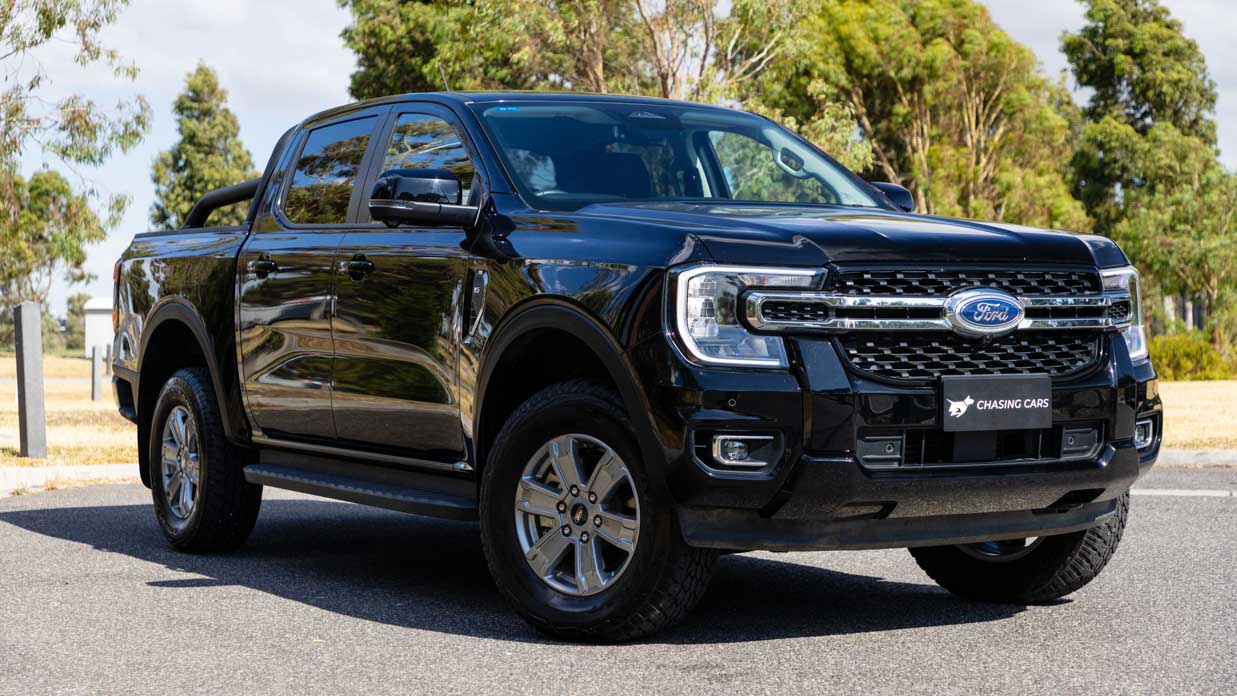
That makes it one of the standout grades in the T6.2 Ranger line-up, the best-selling new passenger vehicle in Australia last year, and whose most popular variants “tend to skew toward the higher model grades, with the exception of the Ranger XL which is among the top selling nameplates,” Ford told Chasing Cars.
While both the twin-turbo diesel four-cylinder and the V6 claim 3.5-tonne braked towing capacities, the Lion PSA 3.0-litre turbodiesel V6 – whose origins date back to 2004 – increases outputs from 154kW/500Nm to 184kW/600Nm. Crucially, the additional 100Nm is available from the same 1750rpm, equating to 20 percent more pulling power right where you want it.
Few other dual-cab rivals can offer this. There are plenty of alternatives out there – from the Mazda BT-50 to the (new) Mitsubishi Triton, Nissan Navara to the strong-selling Toyota Hilux – and most of them offer 3.5-tonne braked towing capability.
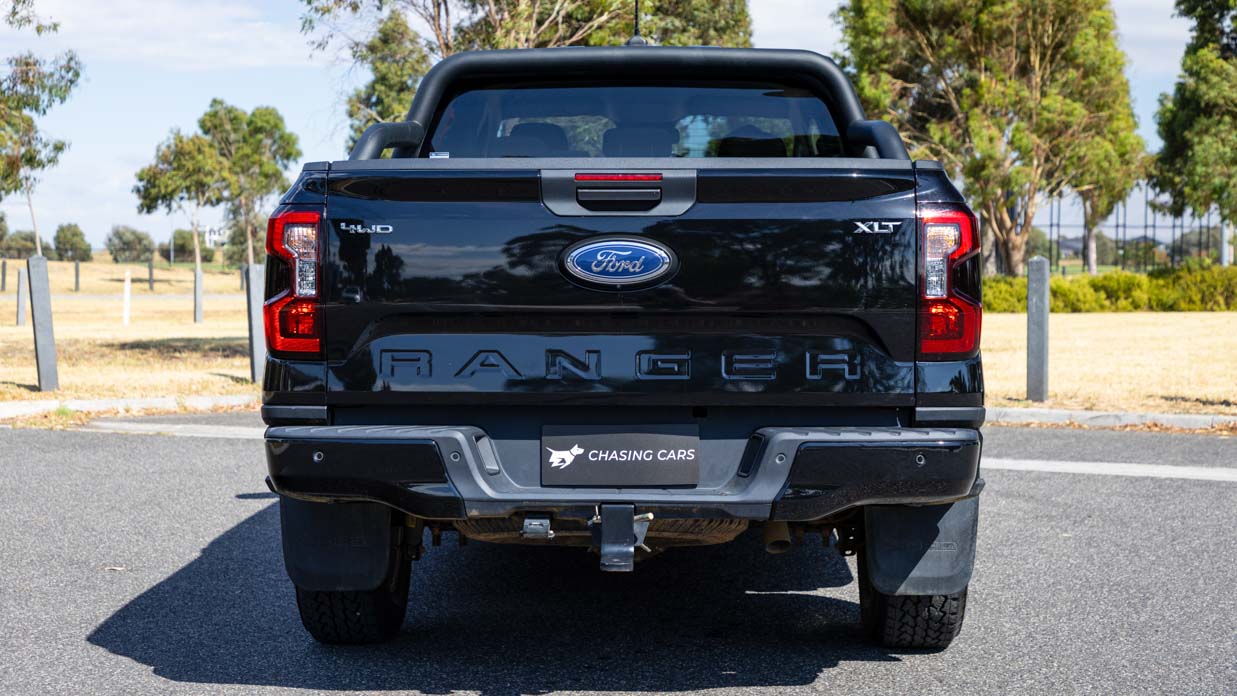
But there’s only one that matches the same turbodiesel V6 grunt as the Ranger, and that’s the Volkswagen Amarok – a vehicle that’s effectively based on the Ranger.
Volkswagen doesn’t offer an Amarok equivalent to the Ranger XLT V6 we’re testing today. The cheapest V6 Amarok is the $73,740 Style, which prices it closer to the $74,840 Ranger Wildtrak V6.
If you are shopping richer Ranger grades, while that’s not our review today, here’s some analysis to consider.
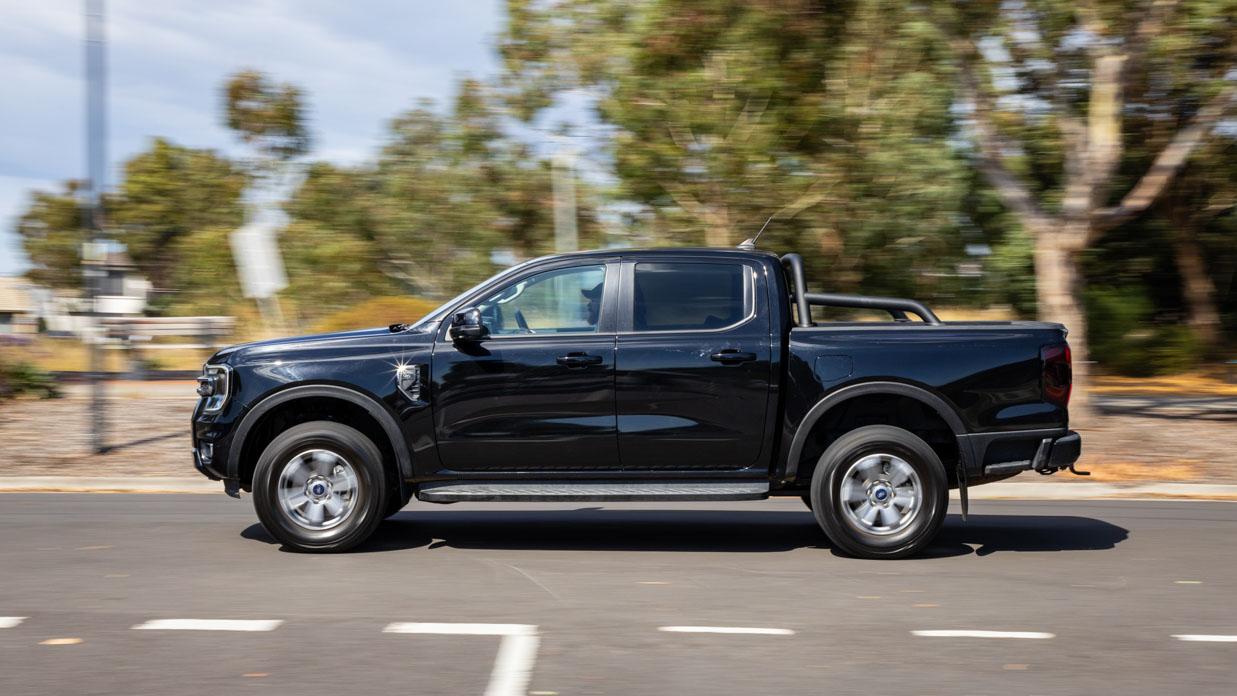
For $1100 less than the Wildtrak V6, the Amarok Style V6 adds matrix LED headlights, a larger digital instrument cluster and some other minor goodies, but that advantage shrinks to $500 if you opt for any colour than white. Premium paint is $990 on Amarok and $700 on Ranger. The Wildtrak comes standard with pricier all-terrain tyres.
For those who will be towing, the Ranger also comes standard with an integrated trailer brake controller, but that’s since been made standard on new Amaroks for 2024.
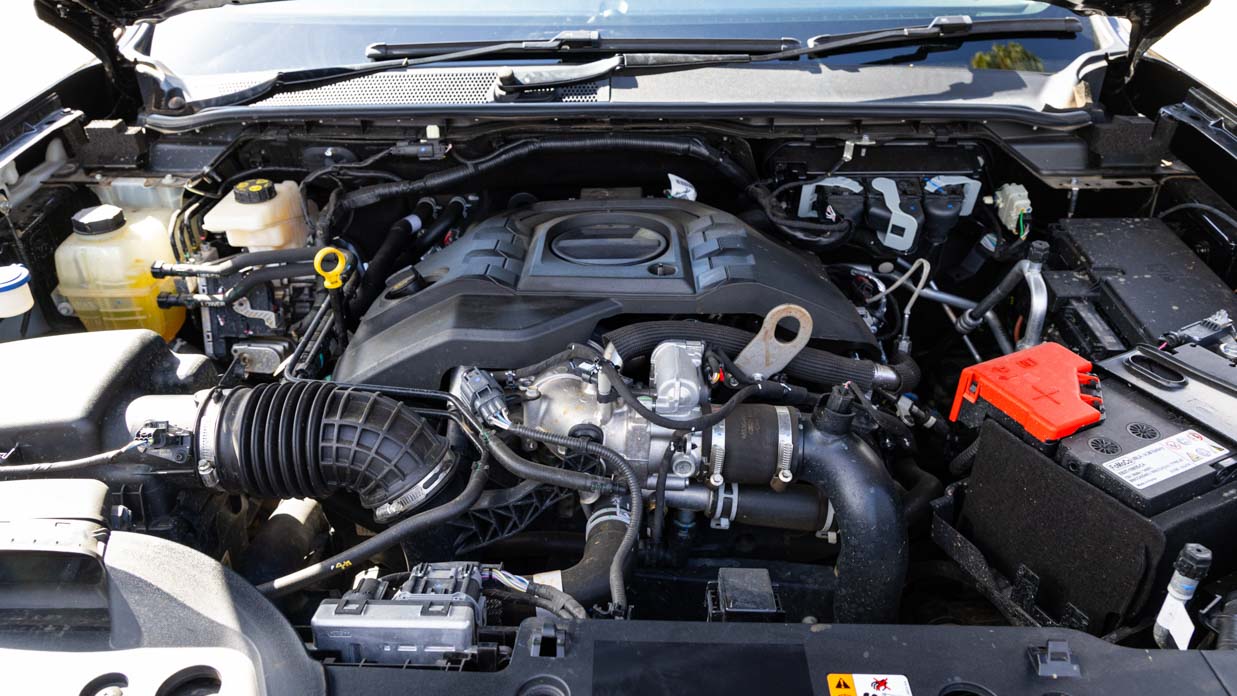
While the 2024.5MY Ranger release is imminent, today’s XLT test vehicle is the 2024MY. The only changes to the XLT for 2024.5MY are the deletion of automatic high beam, and the offering of Pro Trailer Backup Assist as an option.
Ford also told Chasing Cars there is plenty of stock available, unlike not that long ago where there was a queue around the corner for a V6 Ranger of any sort. (There was still a bit of a wait for Ranger Platinum V6 as we closed for press.)
The XLT is intended to be neither spartan workhorse nor too posh, but it’s still orientated more towards the practical buyer. That said, its $68,840 MSRP is still a lot for a ute – and not even the most you can pay for a Ranger, by a long way.
There are seven grades in the Ranger line-up – XL, XLS, XLT, Sport, Wildtrak, Platinum and Raptor. The XLT can be had with either the twin-turbo 2.0-litre inline-four diesel, or the turbodiesel 3.0-litre V6. Both come with a 10-speed torque converter automatic.
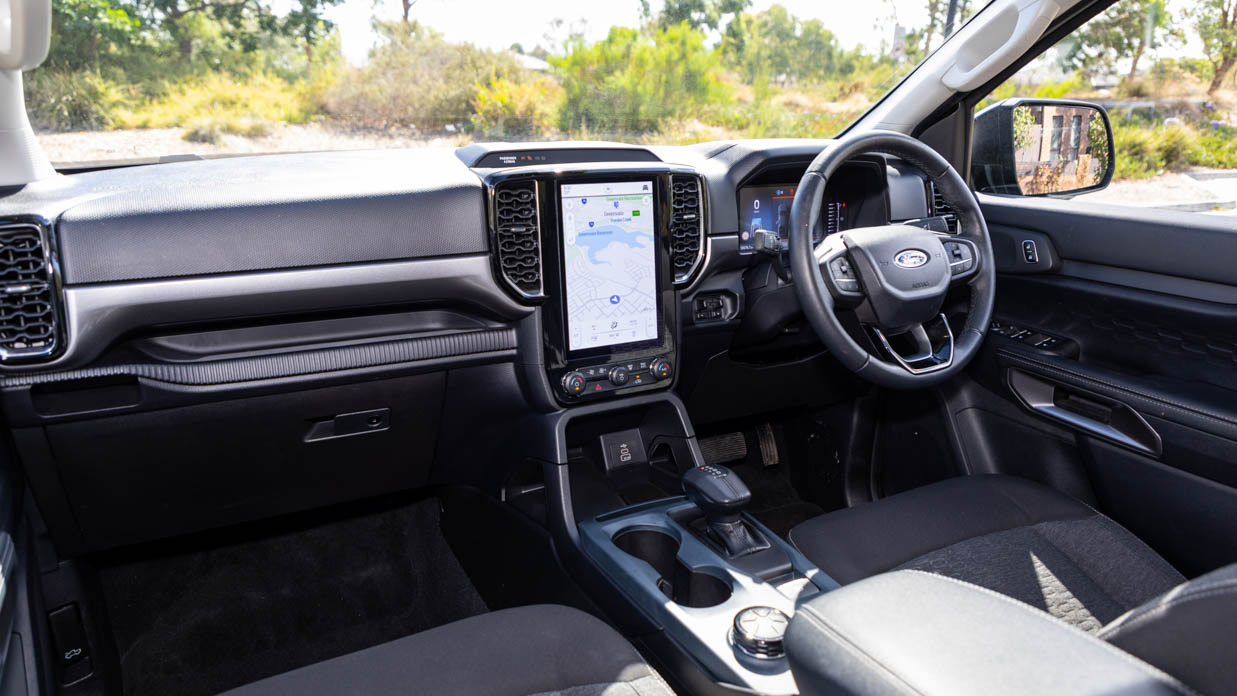
The double-cab XLT V6 we’re testing today has an MSRP of $68,840, although our test vehicle came with $3230 of options. (Hardly more than 12 months ago, a Ranger XLT V6 started from $64,190.)
Standard equipment highlights for the Ranger XLT V6 include:
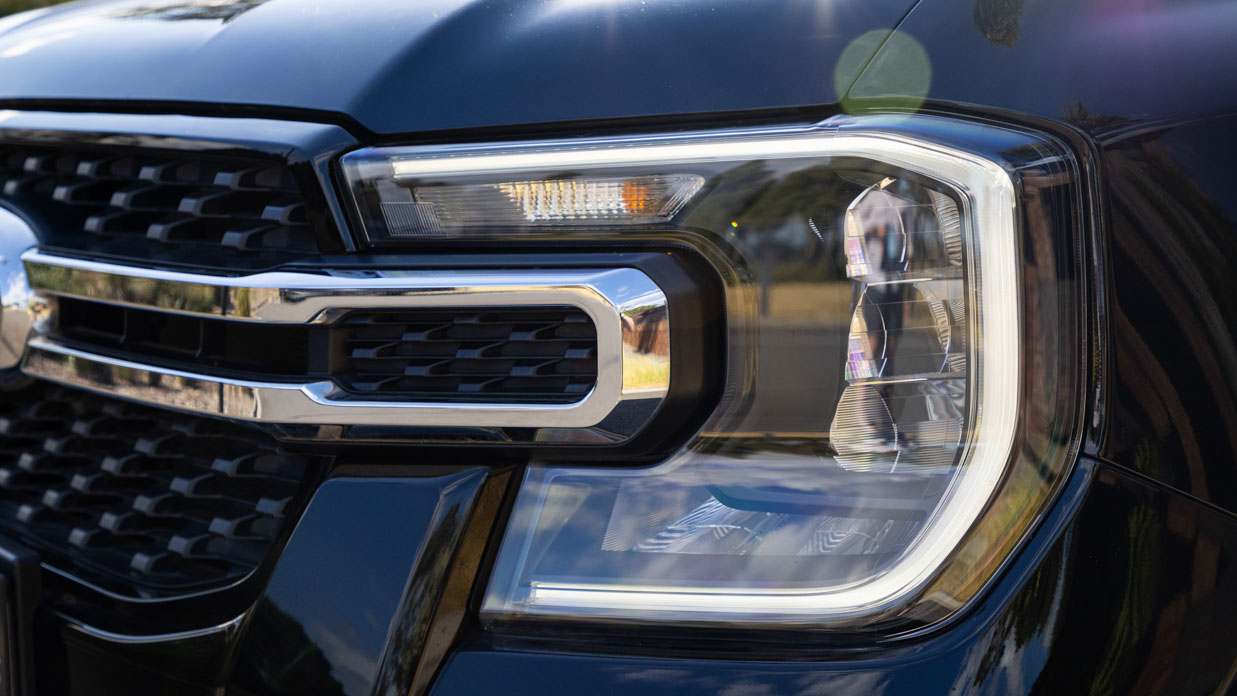
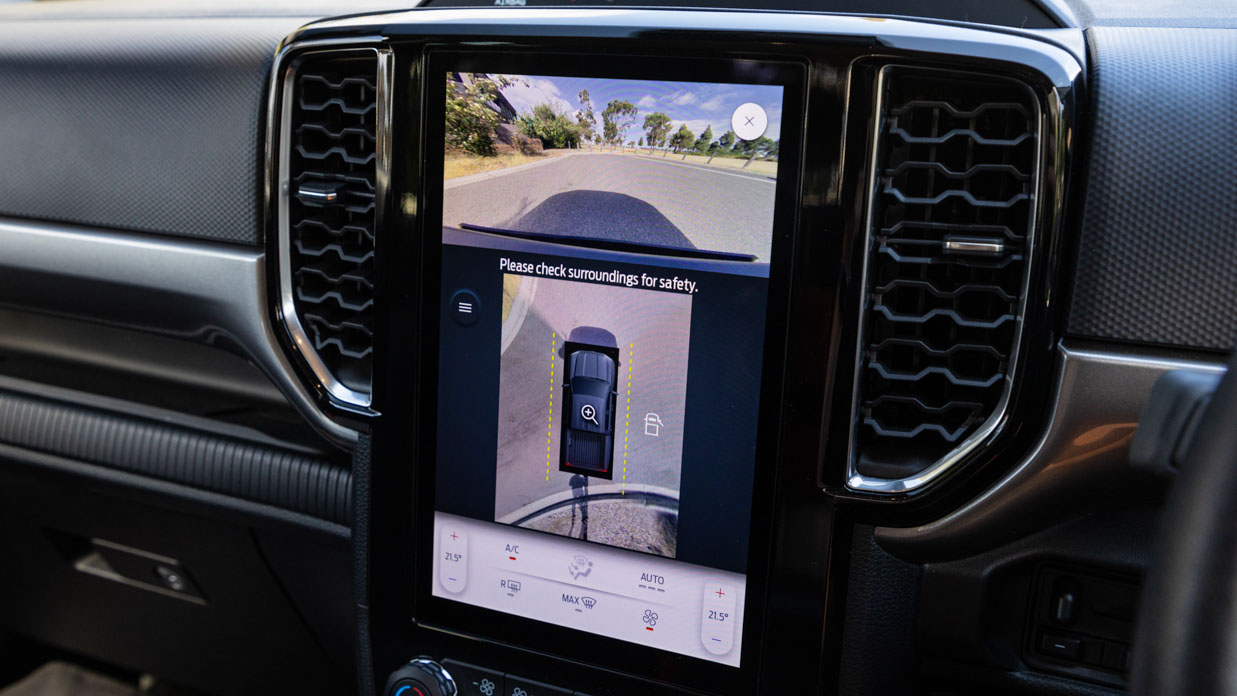
As well as $700 for the Shadow Black paint and $700 for all-terrain tyres, our test vehicle came with the optional $1650 Touring Pack, which adds:
This is a tall vehicle and one you don’t get into, much as you climb into, like a small truck. The side steps are standard for a reason, and you’re grateful for the A-pillar grab handle.
Once behind the steering wheel, the first thing you notice about the Ranger XLT is that you’re perched very high above the road, looking down on even most SUVs. If you love a high, commanding driving position, a dual-cab ute sits you up like a tennis umpire.
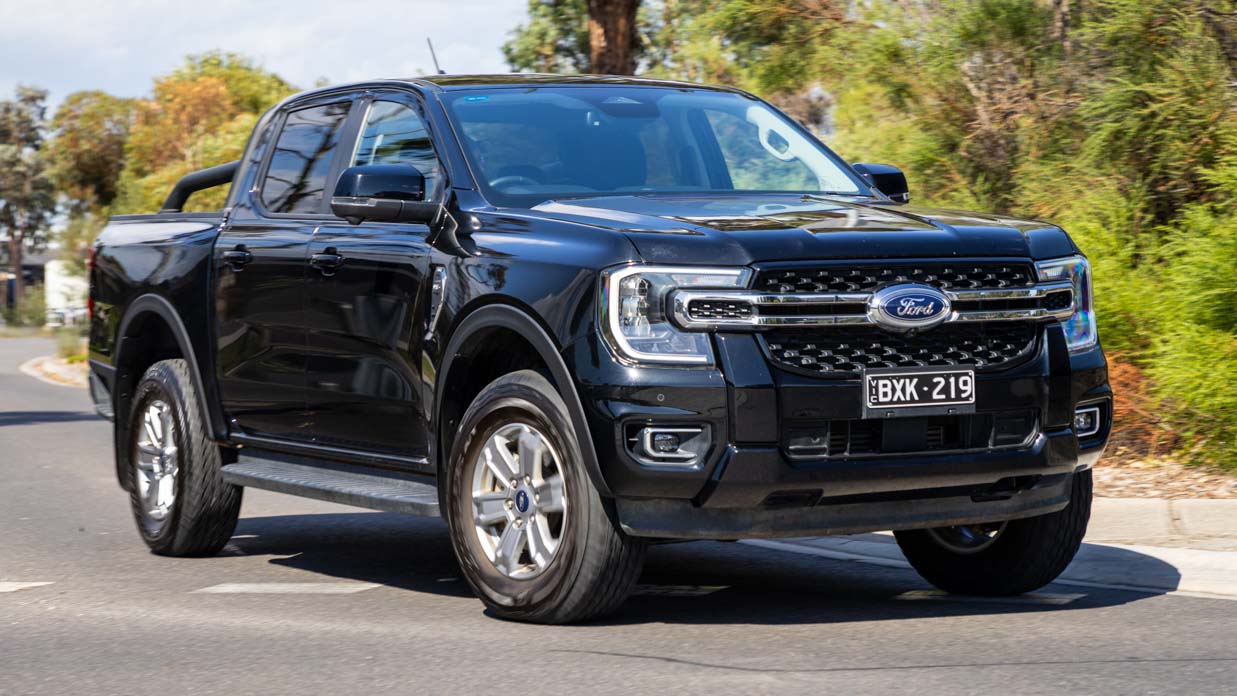
In the urban sprawl, there’s something satisfying about the way the Ranger XLT V6 drives, and a lot of it has surely to do with what’s under the bonnet. The word muscular comes to mind, and for good reason.
In our own testing, the V6 Ranger XLT recorded 7.7sec in the sprint from 0-100km/h, while a twin-turbo four-cylinder Sport took 8.53sec.
There’s plenty of torque no matter the rpm, the V6 never having to labour particularly hard to shift 2332kg of dual-cab ute. It’s not hard to see how this would make a great towing vehicle – not least because the transmission is calibrated to always keep the engine right in its torque sweet spot.
Having 10 gears helps very much in that sense, and the powertrain as a whole is delightfully smooth and refined. The Ranger is also surprisingly well-insulated from outside noise, including that of the engine.
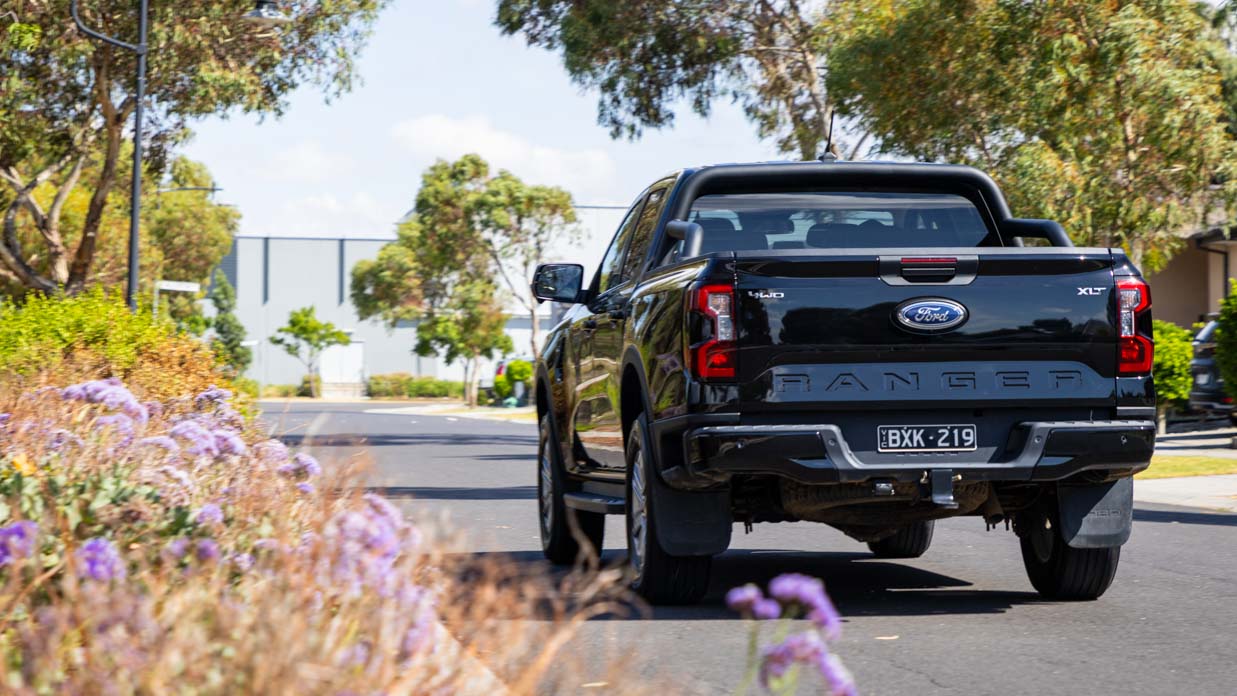
While there’s a diesel engine note to be heard and some satisfying turbo whistle under load, it doesn’t sound like the engine is physically in the interior with you – like it can with some other, cruder dual-cabs.
This one feels a bit more grown-up, the engineering running deeper.
While the ride quality can be a bit jiggly – owing, presumably, to the stiffer rear leaf springs needed to support a potential 1047kg maximum payload – it’s never uncomfortable. All-season tyres would make the Ranger XLT an even nicer drive, as there’s some low-level vibration and noise from the all-terrain tyres at highway speeds.
At 5.4 metres long, 2.2 metres wide and 1.8 metres high – with a 3270mm wheelbase – you’re always conscious that you’re in a larger vehicle. Especially when parking as the long Ranger can easily fill a spot.
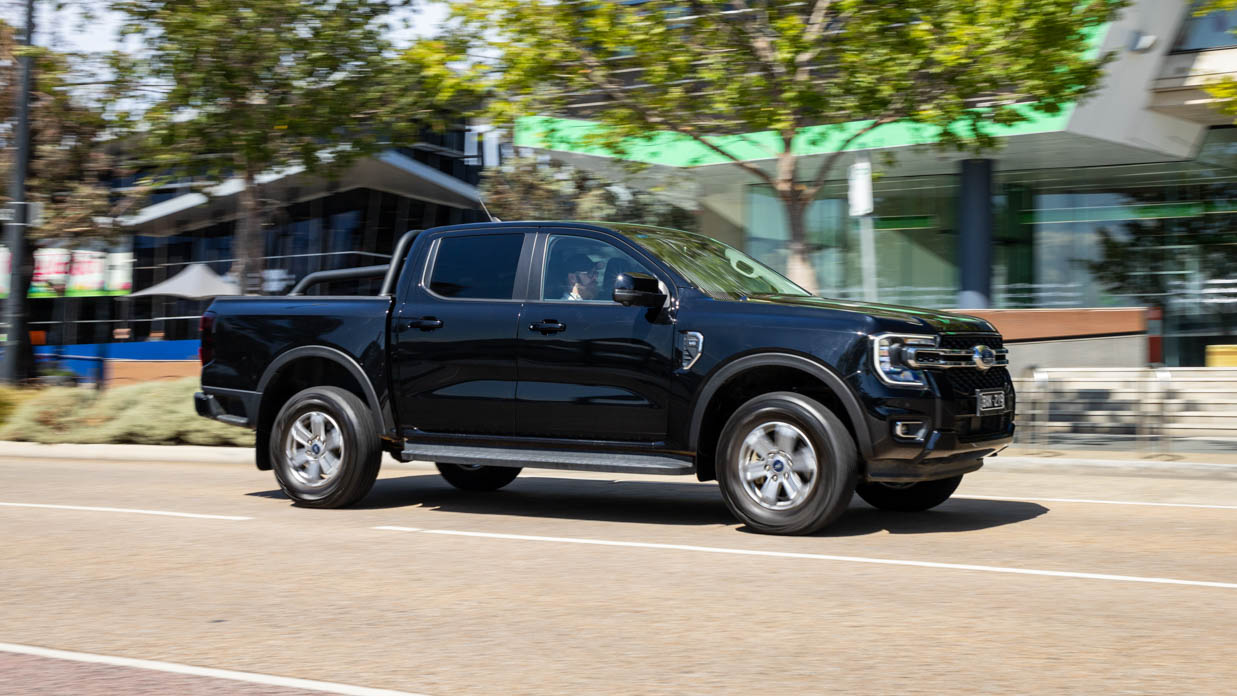
One of the most noticeable differences between a dual-cab ute and, say, an SUV, reveals itself when parking, too: the steering.
The Ranger’s 3.3 turns lock-to-lock means it feels like you’re going hard-to-starboard and back again when doing three-point turns, or getting around car parks, a feeling exacerbated by the long wheelbase. We’d love to see a Ranger, or any dual-cab ute, with a faster steering rack.
The slower steering has an effect dynamically, too, but at least the Ranger XLT V6 makes no claim at being a sports car. While this is the same ladder-frame chassis that underpins the performance-focused, twin-turbo V6 Raptor, the XLT V6 has a lot less to offer the hard-core driving enthusiast.
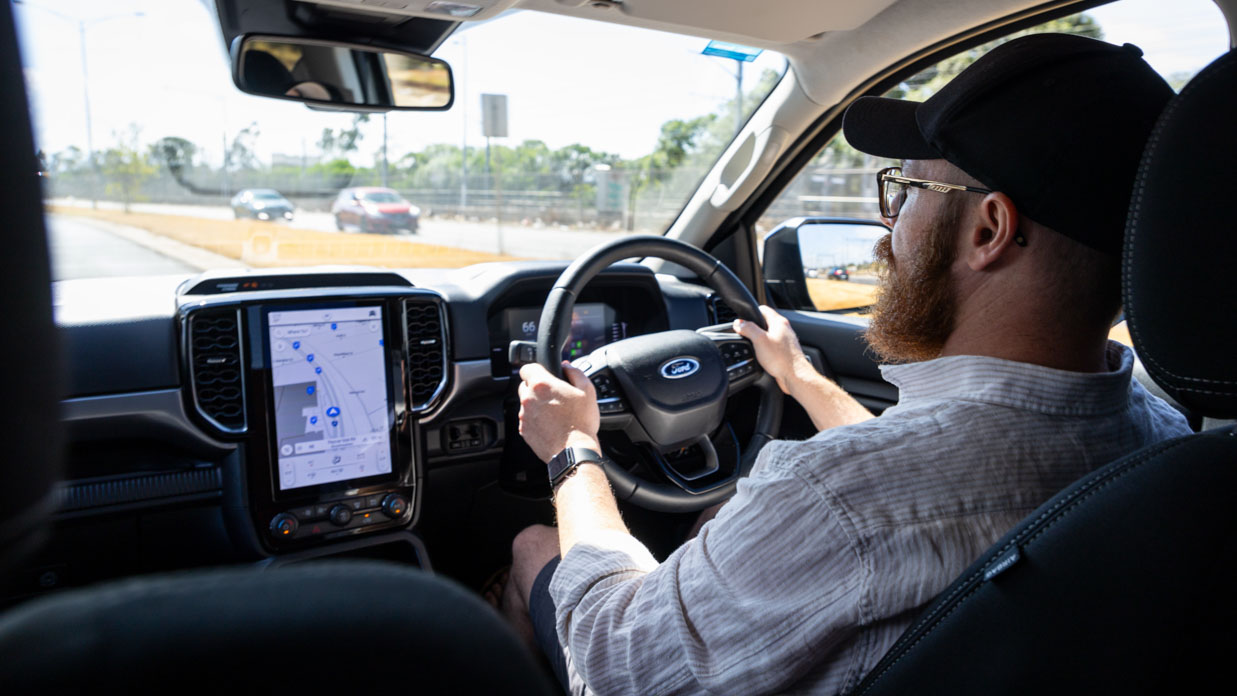
While the Ranger’s chassis feels to have a bit more engineering depth and chops than most other dual-cab utes – which feel like light trucks in the corners – the Ranger is still inherently a tall, heavy dual-cab ute. This means its handling is going to be inferior to even the most average SUV, let alone passenger sedan or hatchback.
That’s especially if the all-terrain Bridgestone Dueller 255/70 R17 tyres are fitted, which seriously reduce the amount of sealed surface grip on offer.
On a dirt road, the all-terrain tyres can be expected to grant a lot more purchase over all-season items, dramatically improving cornering ability and braking performance. If you do most of your driving on unsealed roads, they’re a must.
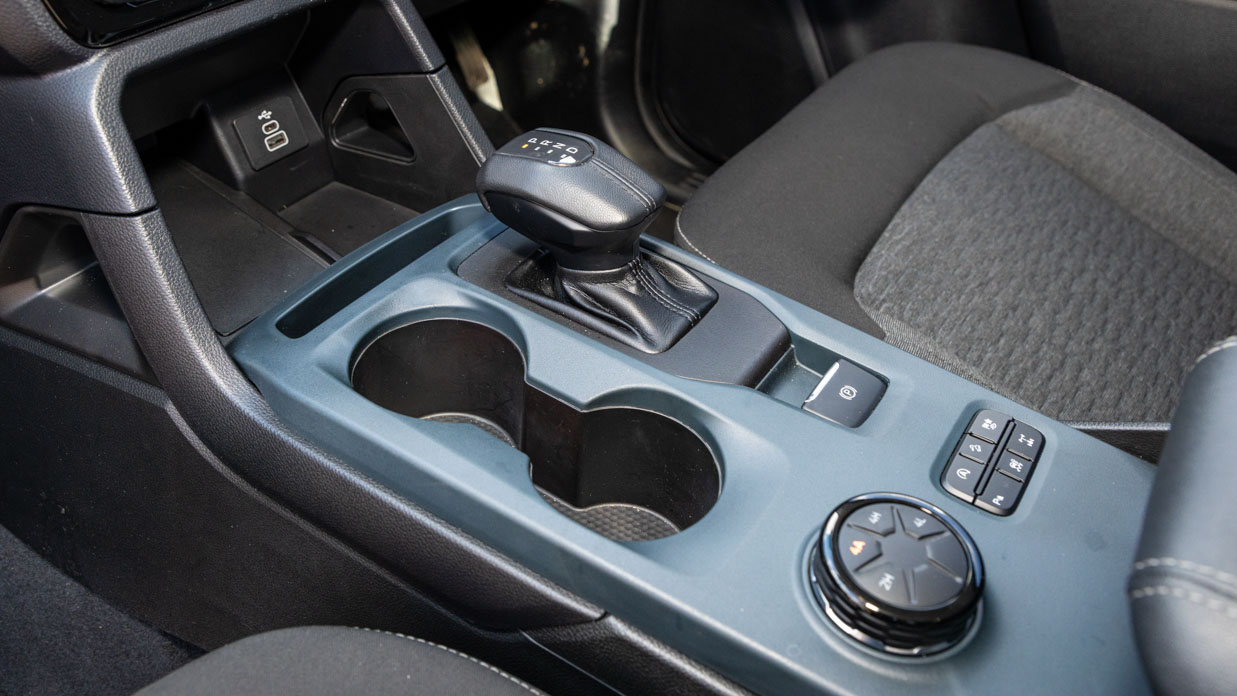
While the transmission offers a true manual mode that won’t change up gears unless you ask, it does ask that you use two little buttons on the side of the transmission shifter. On the whole, find yourself on a winding road and you’ll be hustling along a heavy, under-tyred vehicle that would probably prefer you calmed down a bit.
On the towing front, the XLT’s 6400kg gross combined mass means that with a fully optioned vehicle, with a full tank of fuel, you’ve got 4068kg to play with. If you’re towing the maximum 3.5 tonnes, that leaves 568kg you can put in the ute between passengers, luggage and gear in the tray.
The XLT V6’s payload is a maximum of 1047kg, which decreases as you fit more accessories and add weight to the vehicle.
A tow bar with integrated trailer brake controller is fitted as standard, as is the clever trailer light check (which will cycle through the indicators and brake lights remotely, so you can check the trailer connection solo) and a selectable towing drive mode. The reversing camera also offers a handy top-down trailer hitch view.
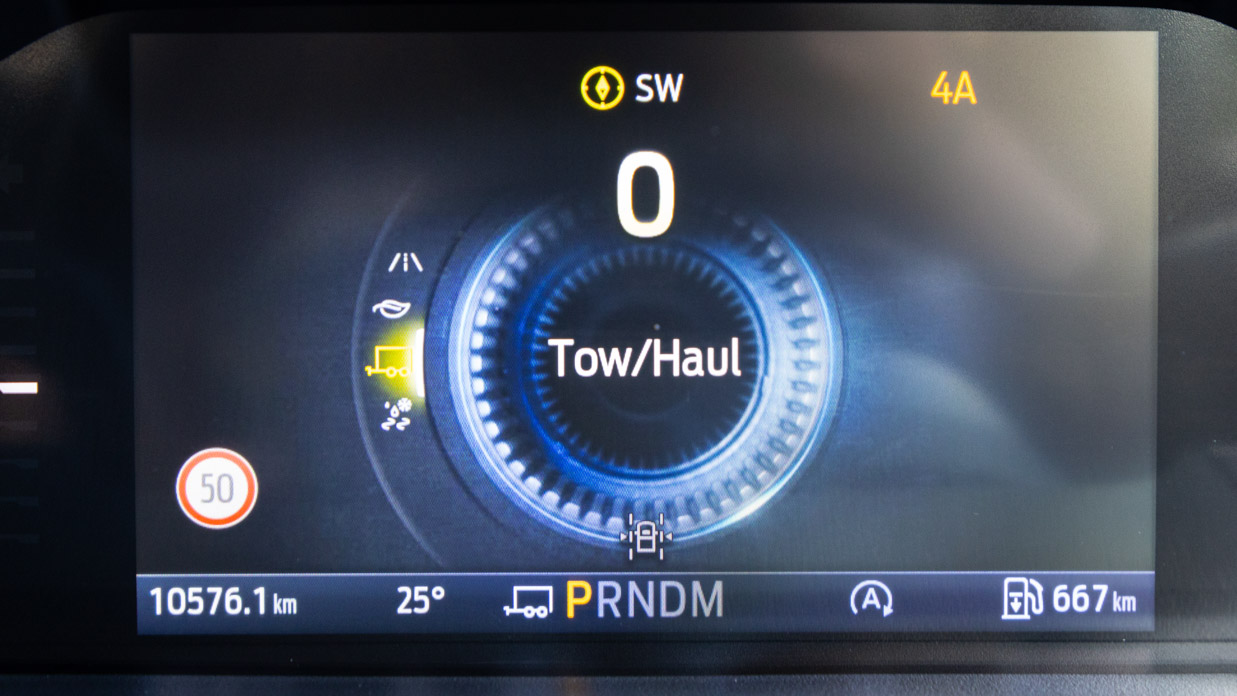
Our test vehicle’s optional Touring Pack included the Pro Trailer Back-Up Assist, in which you can steer the ute using the a dial on the infotainment screen (as the vehicle takes over the steering wheel) while watching the reversing camera.
If you have a long caravan, regularly have to back it into new places, and aren’t the most confident reverser, it might be worth a look.
For those who do a lot of highway driving, the XLT’s advanced driver assistance system is excellent. You can pop on the adaptive cruise and simply rest a hand on the steering wheel as the Ranger confidently tracks in the centre of its lane down a motorway, reducing the exertion required. This means you’re that little bit less fatigued at the other end.
The XLT’s interior has a tough, comfortable, if slightly no-frills vibe, something reinforced by the old school “Built Ford Tough” graphic that comes up on the dash when you start it up.
There’s cloth upholstery, manual front seats and a robust-feeling, vinyl-like upholstery on the doors and other places like the centre console lid. Ford says the steering wheel is a leather item, but based on how it feels, poor Daisy must not have had much of a moisturising routine. Instead, it just feels like vinyl.
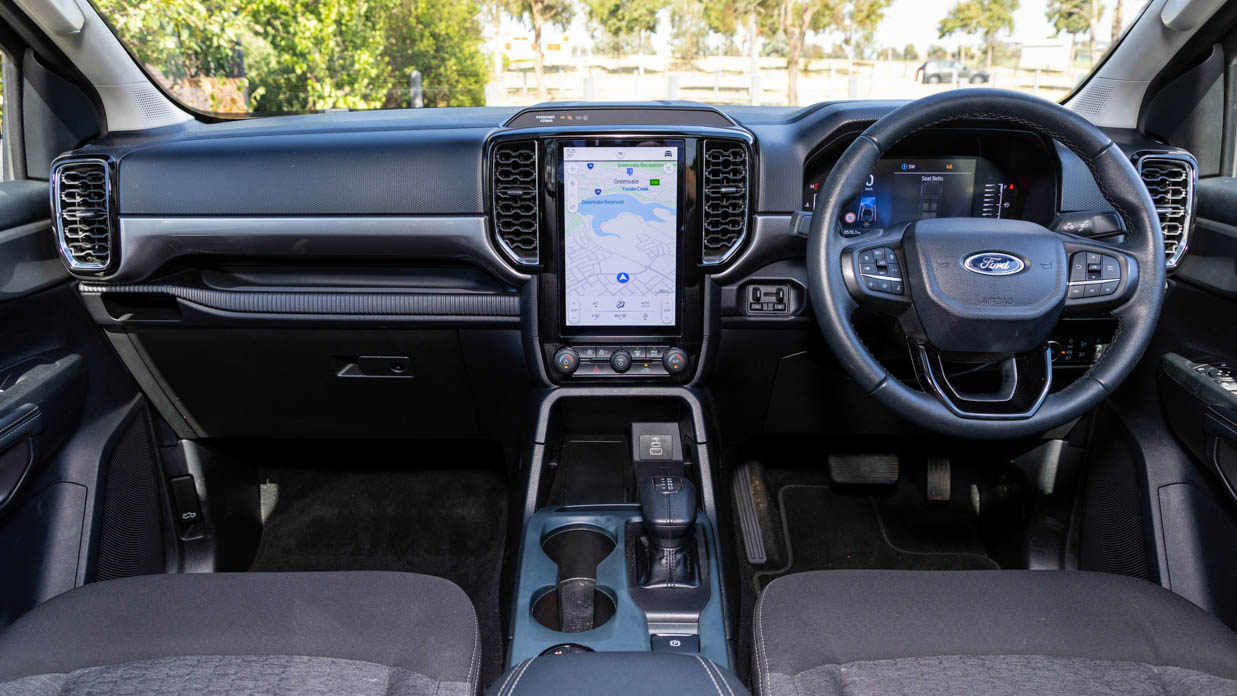
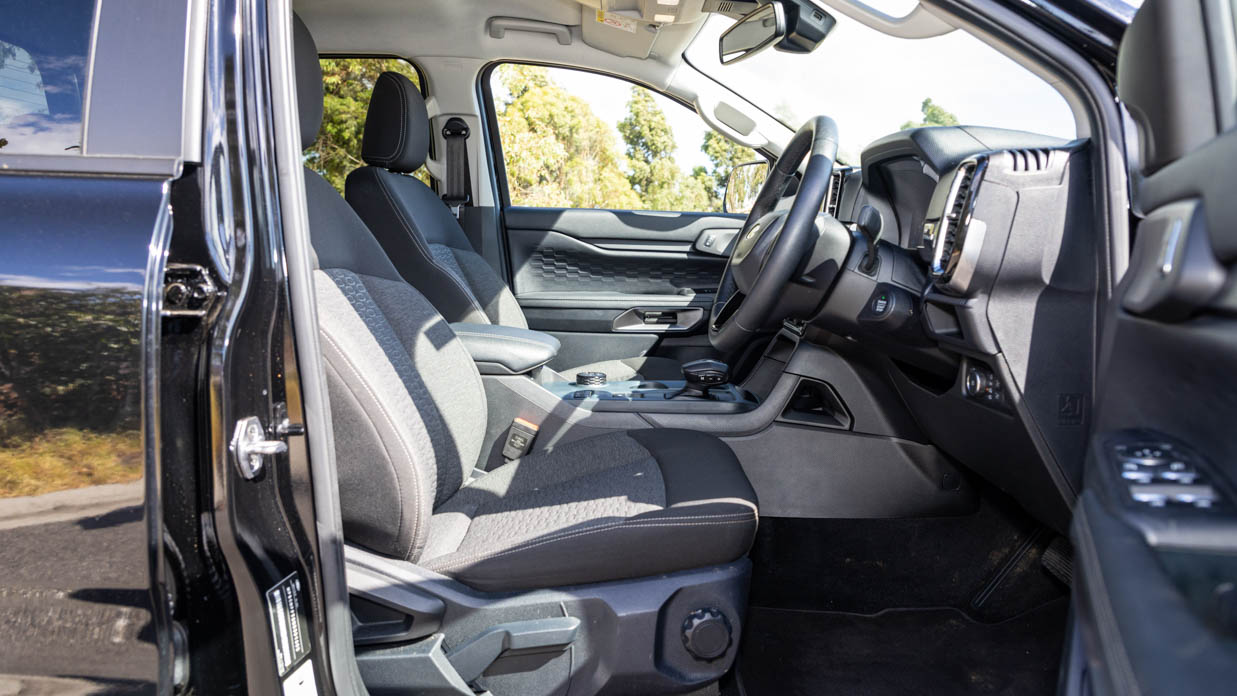
The XLT has a more basic tech offering than richer Ranger grades, with its smaller 8.0-inch digital instrument cluster and 10.1-inch portrait-orientated infotainment touchscreen, although if you were upgrading from an older Ranger and never sat in something like a Wildtrak, you’d still wonder who got carried away with all the screens.
They’re still plenty big enough to see all the information you want nice and clearly, even if it is a pity that the Apple CarPlay display is unattractively squeezed into a smaller window relative to the rest of the screen.
Apple CarPlay and Android Auto are both wireless, but the XLT does without a wireless phone charger, something that arrives standard on the next Ranger grade up, the Sport.
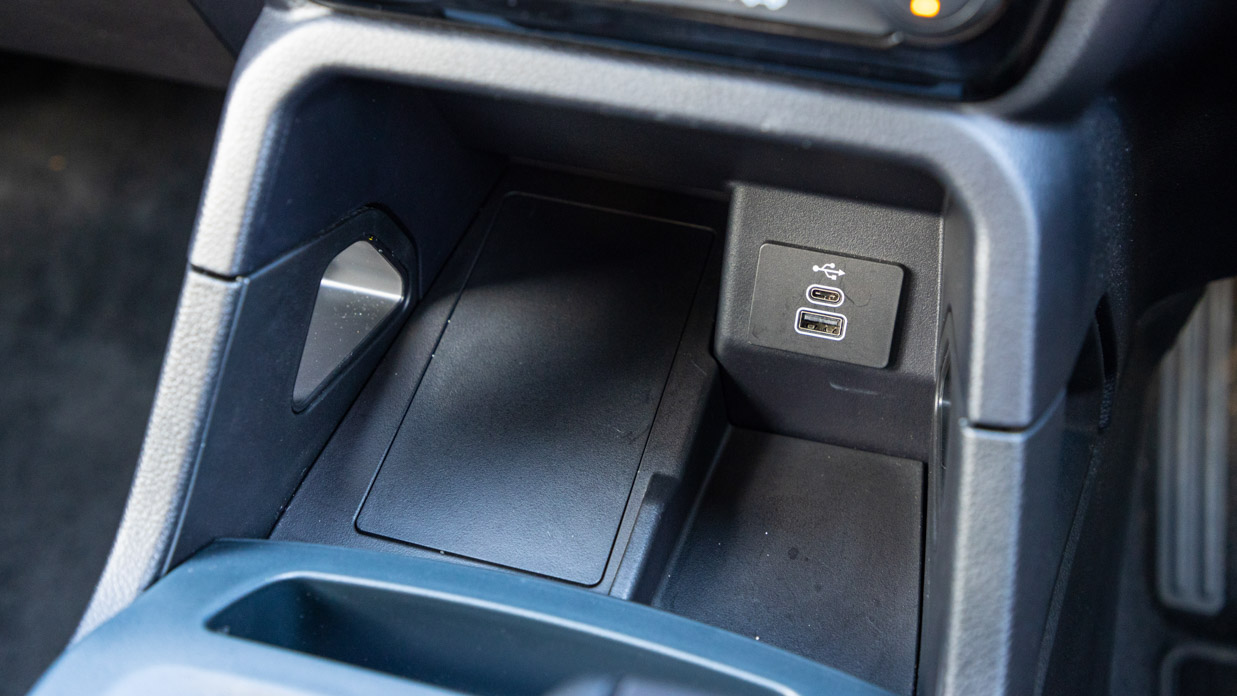
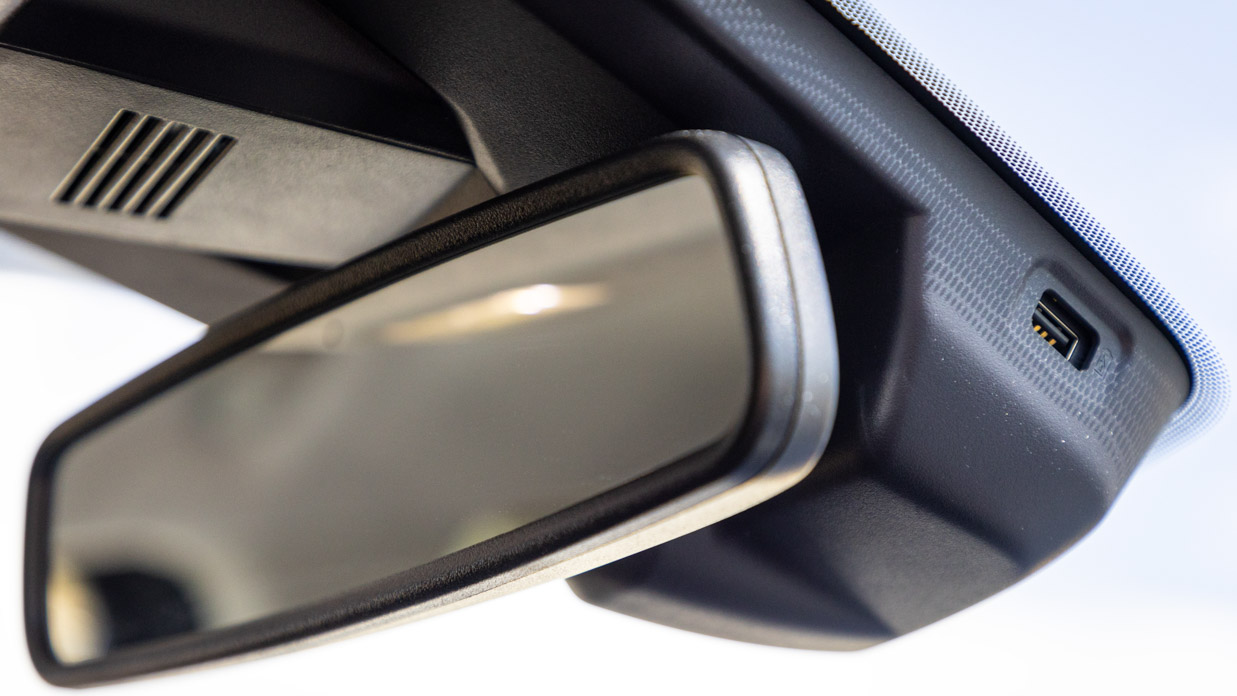
Front row stowage is great, with a large centre console bin and big bottle holders on the doors. The XLT misses out on the clever folding, dashboard-integrated drink holders of other Rangers. It also forgoes lights for the vanity mirrors.
While the back seat is slightly compromised – this is a dual-cab ute, not an SUV, after all – with a more thinly padded backrest and reduced under-thigh support, it still has satisfactory space and comfort for two adults (it can seat three).
There’s a centre armrest and some under-seat stowage and the backrest folds flat, something to note if you’re shopping against Amarok, with its more thickly padded backrest can’t.
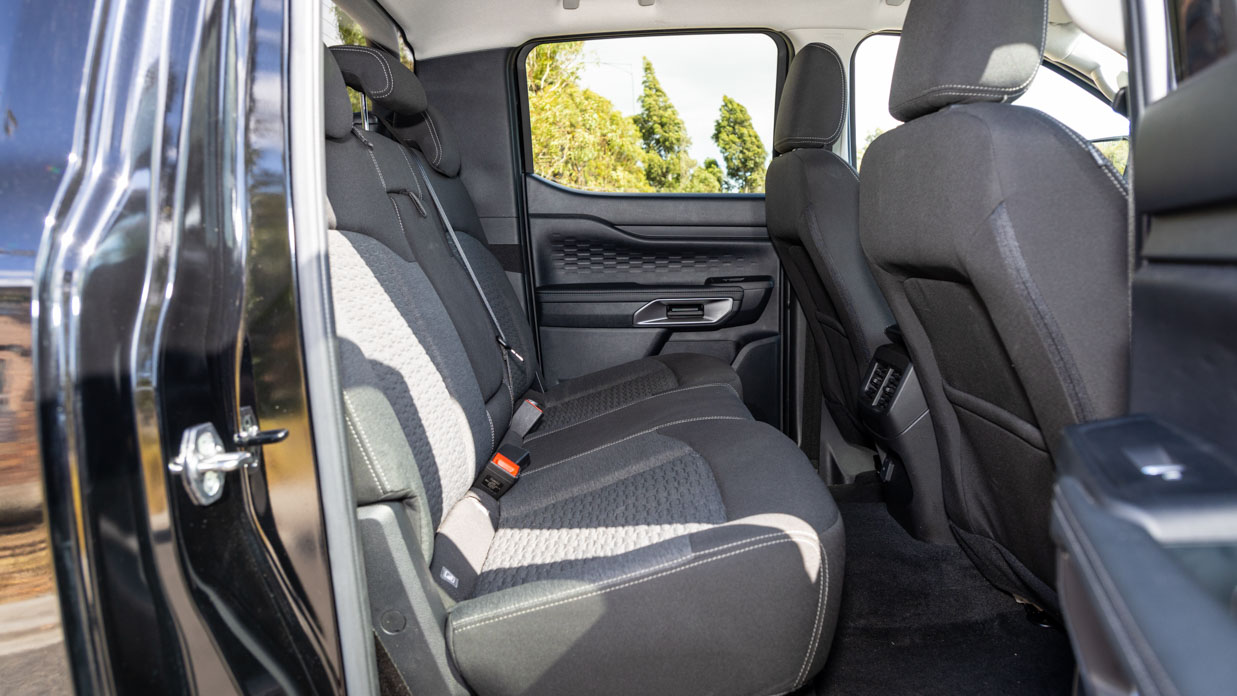
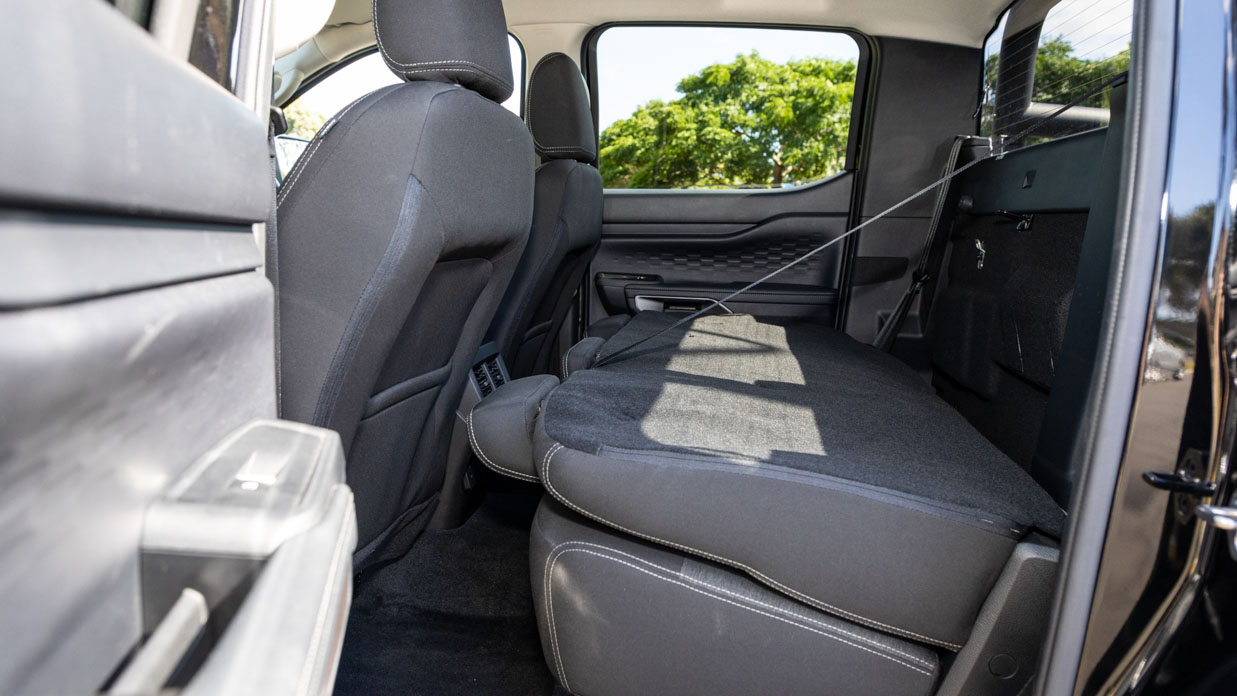
For child seats, there are two sets of Isofix points on the outboard rear seats and two top tether anchorages. Most SUVs have three top tether anchorages.
While there are two rear air-vents, for parents who love to distract their kids with iPads on long journeys, the XLT has no USB outlets for the back seats at all, but rather just a single 12-volt outlet.
With its 1464mm length and 1217mm minimum width between the wheelhouses, the tray is nice and large, enough to fit a Euro pallet as intended by Ford. The sprung tailgate is easy to drop and raise though it’s no damped like you’ve find in an Isuzu D-Max.
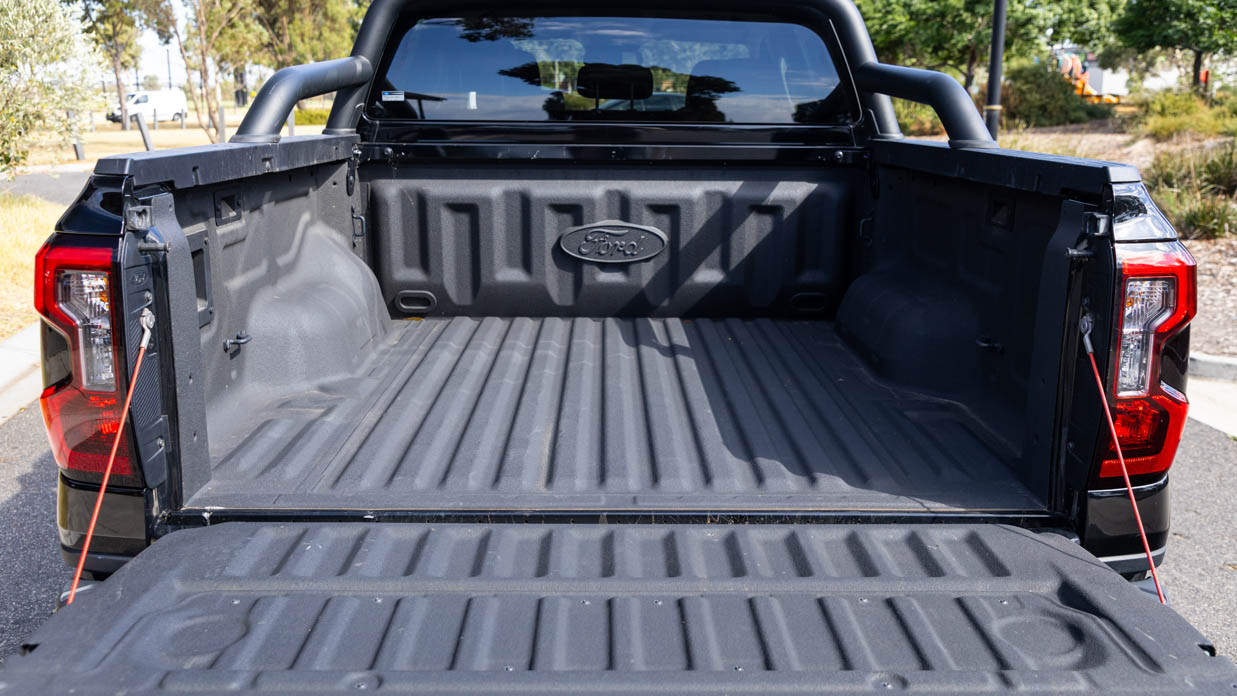
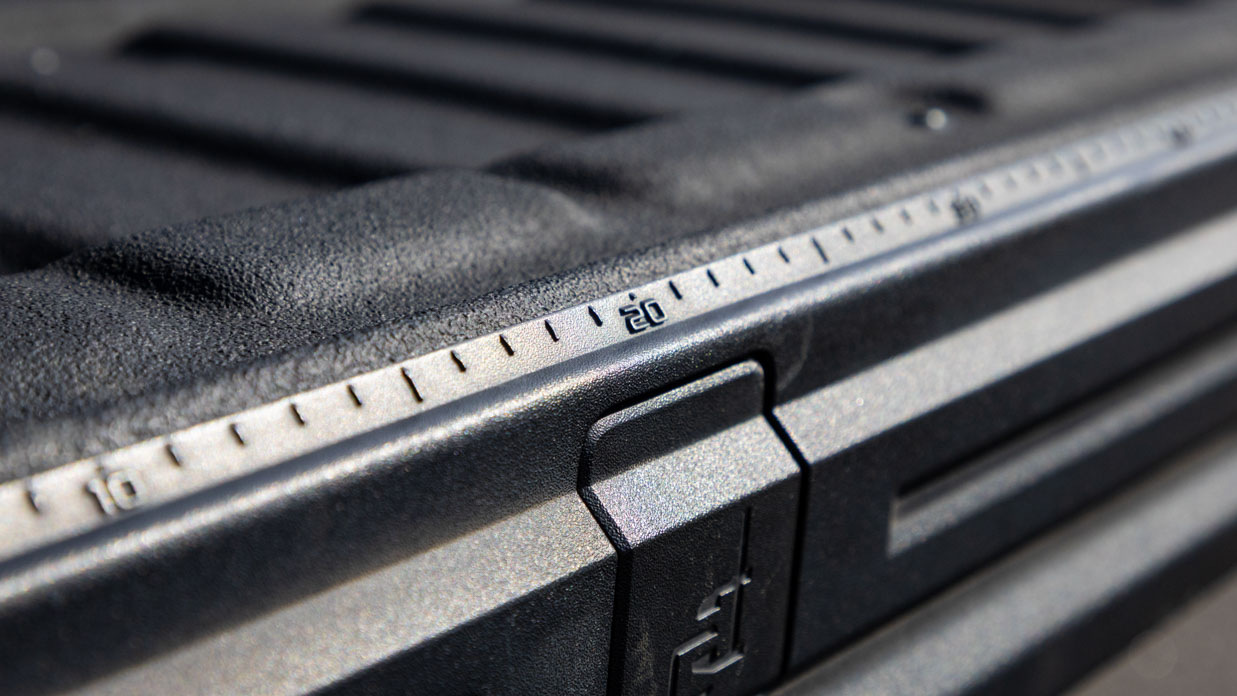
There’s also a 12-volt outlet and some other clever additions such as trapdoor openings for securing C-clamps. The standard sports bar helps differentiate the XLT from the lower grade XLS, although a manual roller shutter is a $3000 option.
Unlike many passenger cars these days, there’s a full-size 17-inch spare wheel – slung under the tray – increasing peace-of-mind for country owners.
For the most part, it’s a tough, honest, practical interior with a bit of tech and comfort, the kind of place that could handle dogs, kids and whatever else you wanted to throw at it.
The Ranger is a very safe vehicle, and particularly safe by dual-cab ute standards. That’s owing to the fact it’s a later-generation model, benefitting from the newest engineering knowhow, having only entered production in 2022.
Compared to regular hatchbacks, sedans and SUVs, the Ranger’s inherent, heavy dual-cab basis would not provide the same braking performance in an emergency. And that’s even with the XLT getting disc rear brakes, unlike cheaper grades that fit drums.
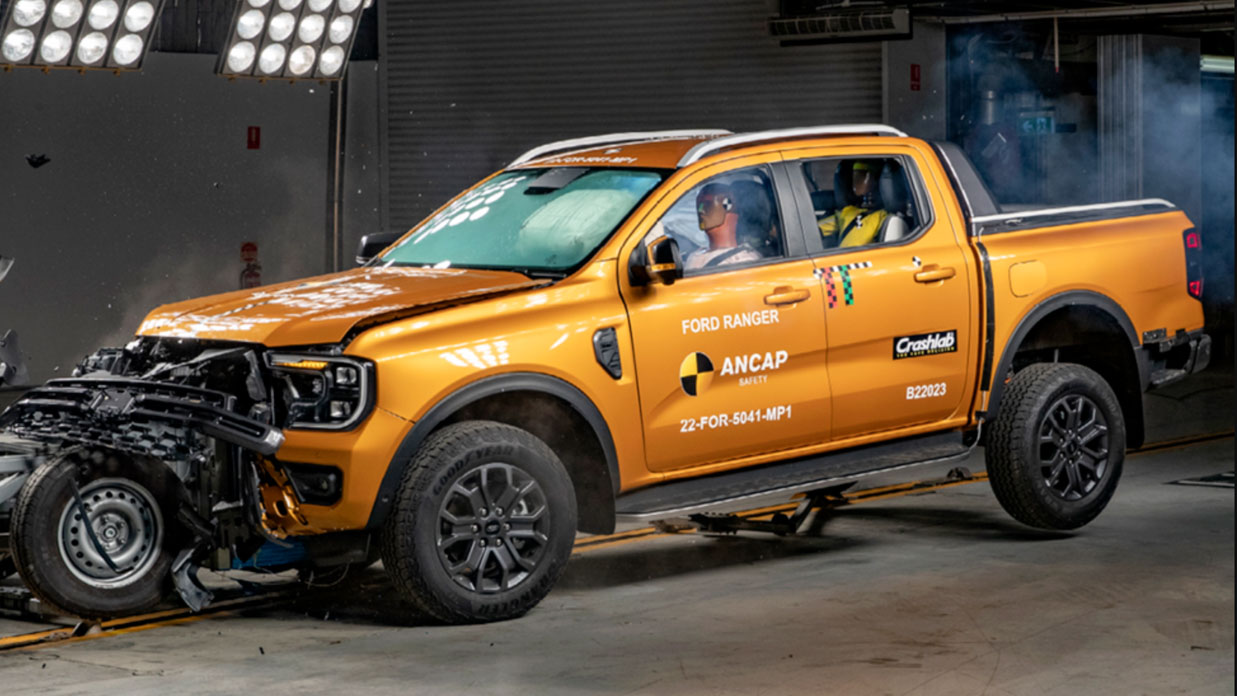
That’s just because it weighs a lot more than the average passenger car. In our own testing, we’ve recorded a Ranger XLT V6 braking from 100km/h to a stop in 43.76 metres, which is nothing special at all. And that was on more bitumen-friendly all-season tyres.
The effect would doubtlessly be amplified on all-terrain tyres, which offer compromised bitumen performance compared to standard road tyres. Just things to keep in mind.
That all said, the Ranger scored the maximum five stars in crash-testing by the local Australasian New Car Assessment Program (ANCAP) in 2022. It also comes with advanced safety features of the latest vehicles, such as a front-centre airbag.
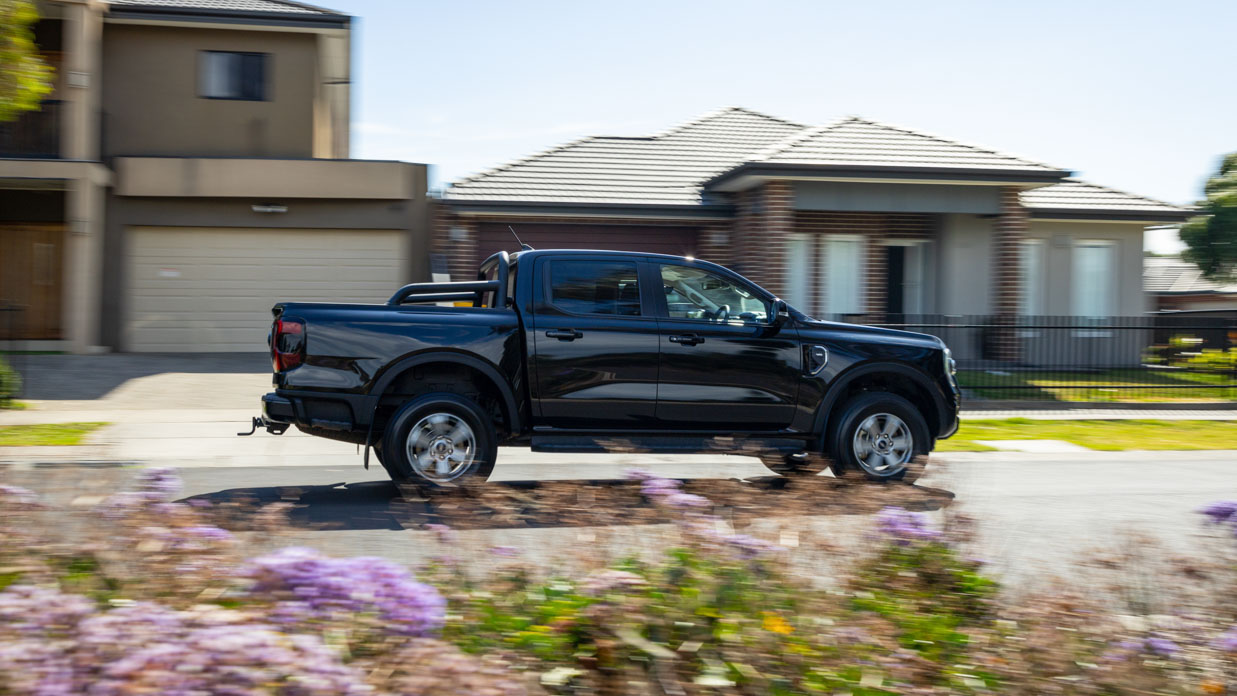
The following safety features are standard on the Ranger XLT V6:
We found the Ranger’s active safety systems such as lane-keeping to work well – and its advanced driver assist system, which engages lane-centring with the adaptive cruise control, is one of the best we’ve tried of any new model. It’s easy to trust, tracking to the centre of the lane confidently.
The Ranger obviously uses more fuel than your typical SUV.
For the V6, Ford claims combined fuel use of 8.4L/100km using the ADR81/02 measurement standard. The four-cylinder is claimed to use 7.2L/100km.
In our own real-world testing, we recorded approximately 6.3L/100km on the motorway, 20L/100km during ‘sporty’ driving and you can expect to get around 10.3L/100km overall. The large, 80-litre fuel tank means fewer petrol station visits.
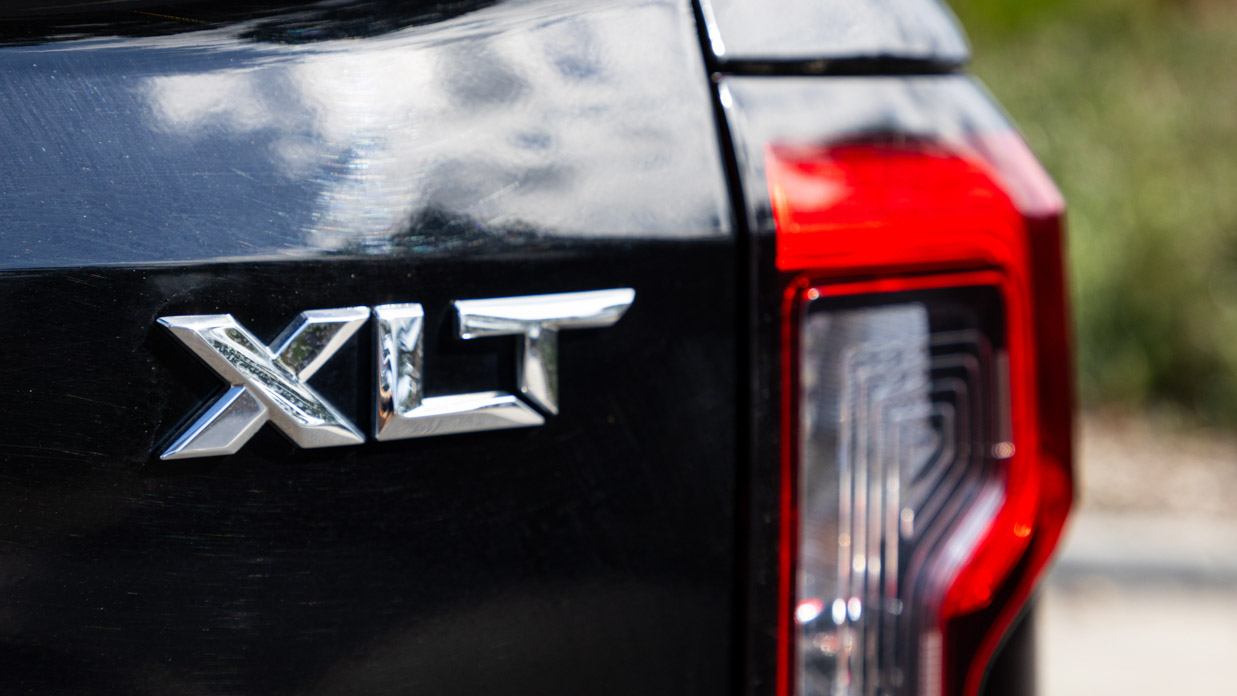
We would estimate the V6 would use less fuel than the four-cylinder when towing.
The Ranger XLT V6 will cost you $1936 to service over five years, with service intervals of 15,000km or 12 months.
Given the continued red-hot demand for the V6 Ranger models, it’s probable your XLT will hold its value better than a four-cylinder model, helping the overall lifetime-cost proposition.
For those who want the oomph and don’t need all the frills of the pricier grades, the XLT does a stand-up job. It mixes mod-cons with workhorse in just the right way for a great many people, feeling neither too posh nor too spartan. It’s a very well-judged effort specification-wise.
Given that the cheapest Amarok V6 is positioned closer to Ranger Wildtrak V6, the cut-price XLT V6 is also effectively without peer in the Australian dual-cab ute market. And getting the V6 over the four-cylinder for towing is a no-brainer.
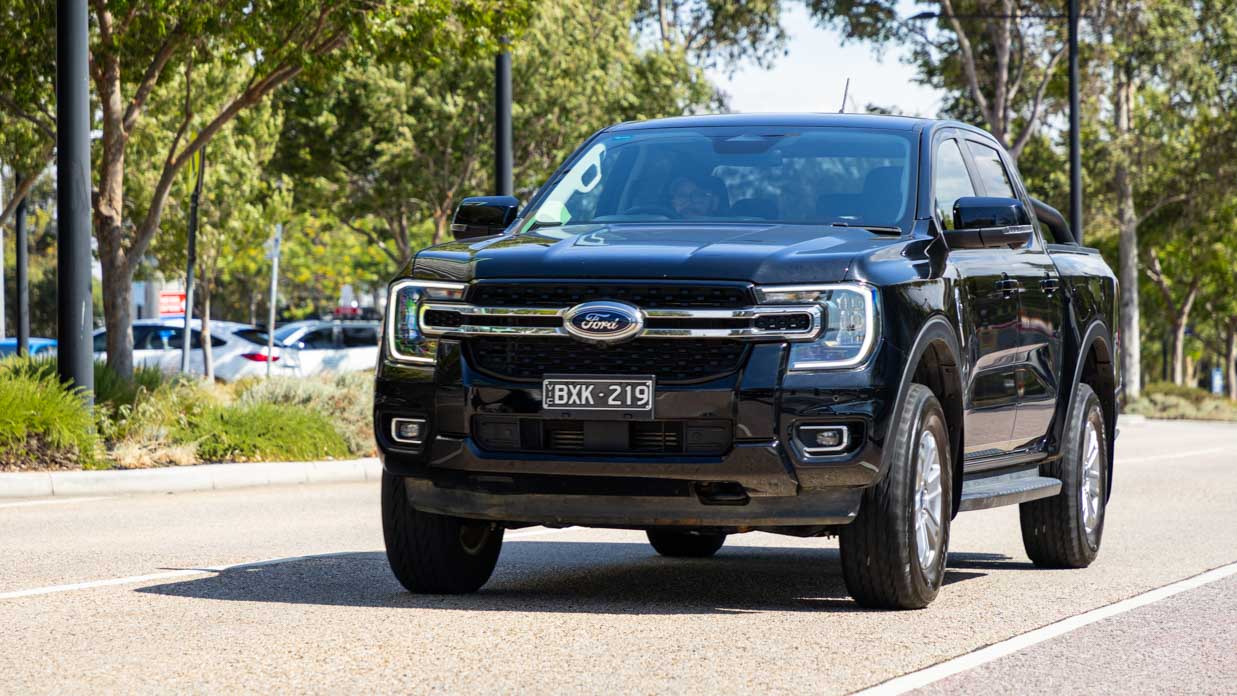
Even if you don’t have anything to tow, there is something satisfying and effortless about the V6’s power and torque, in much the same way that, once upon a time, you might have got the V8 over the six simply for the grunt alone.
In a greater sense, the Ranger is still the benchmark dual-cab ute as well. It’s as close to a car as a dual-cab ute has come, and makes the Hilux – which can’t be had with a V6 – feel a bit like a tarted-up truck.
Key specs (as tested)
About Chasing cars
Chasing Cars reviews are 100% independent.
Because we are powered by Budget Direct Insurance, we don’t receive advertising or sales revenue from car manufacturers.
We’re truly independent – giving you Australia’s best car reviews.
The estimate provided does not take into account your personal circumstances but is intended to give a general indication of the cost of insurance, in order to obtain a complete quote, please visit www.budgetdirect.com.au. Estimate includes 15%^ online discount.
^Conditions Apply
Budget Direct Insurance arranged by Auto & General Services Pty Ltd ACN 003 617 909(AGS) AFSL 241 411, for and on behalf of the insurer, Auto & General Insurance Company Limited(ABN 42 111 586 353, AFSL 285 571).Because we don’t know your financial needs, we can’t advise you if this insurance will suit you. You should consider your needs and the Product Disclosure Statement before making a decision to buy insurance. Terms and conditions apply.
Indicative quote based on assumptions including postcode , 40 year old male with no offences, licence suspensions or claims in the last 5 years, a NCD Rating 1 and no younger drivers listed. White car, driven up to 10,000kms a year, unfinanced, with no modifications, factory options and/or non-standard accessories, private use only and garaged at night.
^Online Discounts Terms & Conditions
1. Discounts apply to the premium paid for a new Budget Direct Gold Comprehensive Car Insurance, Third Party Property Only or Third Party Property, Fire & Theft Insurance policy initiated online on or after 29 March 2017. Discounts do not apply to optional Roadside Assistance.
2. Discounts do not apply to any renewal offer of insurance.
3. Discounts only apply to the insurance portion of the premium. Discounts are applied before government charges, taxes, levies and fees, including instalment processing fees (as applicable). The full extent of discounts may therefore be impacted.
4. We reserve the right to change the offer without notice.